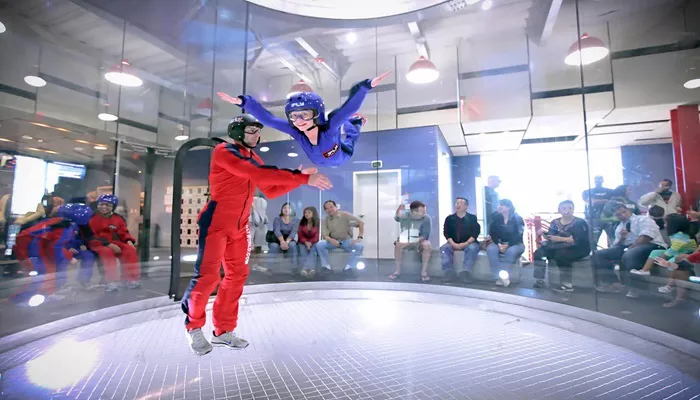Indoor skydiving is a simulated experience of free-fall flight. It takes place in a vertical wind tunnel. A large fan pushes air upwards, creating the effect of floating. Many choose this over outdoor jumps. It feels safer and more controlled. But there are still risks. This article explores the real dangers of indoor skydiving. It compares them with outdoor jumps. It also highlights key safety measures.
Understanding the Environment of Indoor Skydiving
How Vertical Wind Tunnels Work
A vertical wind tunnel is a structure where high-speed fans push air upward. This flow lifts the person into the air. These tunnels are enclosed. Flyers use body positioning to control movement. Professional instructors monitor the activity. While the environment is controlled, accidents can happen. Injuries from bad landings, mid-air collisions, and equipment issues are possible.
Key Differences from Traditional Skydiving
Indoor and outdoor skydiving share some features. But the differences matter when it comes to safety. In outdoor skydiving, altitude and parachute deployment add risk. Skydiving altitude affects jump time and pressure. Indoor skydiving removes those concerns. But body control, gear safety, and instructor skill still matter.
Common Risks Associated with Indoor Skydiving
Injuries from Collisions
Flyers can collide with tunnel walls or each other. Poor body control can lead to head, neck, or shoulder injuries. Beginners are at greater risk. Professional training helps. But errors still occur. Injuries are usually bruises or sprains. In rare cases, fractures happen. Instructors try to prevent this with clear instructions and hand signals.
Strains and Overuse Injuries
Holding proper flying positions takes effort. Muscles in the back, shoulders, and legs are involved. Long sessions or bad form can lead to strain. Indoor skydiving is low-impact. But repetitive use of certain muscles may cause overuse injuries. Stretching and training reduce this risk. Professionals warm up before sessions.
Equipment Malfunctions
Equipment includes helmets, suits, and ear protection. If helmets are loose, they can shift during flight. This can block vision or cause distraction. Poor-quality flight suits can tear. These failures increase the chance of accidents. Maintenance and quality control are vital. Facilities should inspect equipment regularly.
Psychological Effects
Some people panic in enclosed spaces. The loud noise and strong air pressure can cause fear. First-timers may experience sensory overload. This can lead to stress or anxiety. Preparation helps. Professional facilities offer pre-flight briefings. Mental readiness is key. Confidence improves safety.
Comparing Indoor and Outdoor Skydiving Risks
Fewer Life-Threatening Dangers Indoors
Outdoor skydiving has serious risks. Equipment failure, high altitude, and parachute issues are life-threatening. According to experts, tandem skydiving height can add pressure on the body. Indoor skydiving removes those risks. There is no parachute. No plane. No hard landings. This makes it ideal for beginners.
Consistent Safety in Controlled Conditions
Indoor wind tunnels are consistent. Weather is not a factor. That makes them safer than outdoor jumps. But the same safety mindset must be applied. Controlled does not mean risk-free. Proper training and equipment are always necessary.
Precautions and Safety Measures
Proper Training and Instruction
Beginners receive instruction before flying. They learn basic body positions. They practice hand signals. Trainers are present during the flight. This reduces the chance of mistakes. In professional environments, safety is always the priority. Following instructions lowers the risk.
Wearing the Right Gear
Flight suits should fit well. Helmets must be secure. Ear protection is often required due to noise. Shoes should be tight-fitting and light. Facilities provide these items. Flyers must check everything before flight. Even small equipment faults can lead to accidents.
Medical Readiness
People with neck, back, or joint problems should consult a doctor. The pressure inside the tunnel can strain the body. Some people with heart or neurological conditions may not be suitable candidates. Facilities usually ask for medical declarations. Full disclosure ensures safety.
Emergency Stop Systems
Wind tunnels have emergency shut-offs. Operators can stop airflow if needed. Instructors can also help guide flyers down.
These systems are tested regularly. Knowing they exist adds confidence for flyers.
Who Should Be Cautious About Indoor Skydiving?
Children and Elderly Participants
Most facilities have age and weight limits. Children under three or four feet tall may be at risk due to turbulence. The elderly may have bone or joint problems. While it is accessible, safety should be judged on a case-by-case basis.
People with Health Conditions
People with ear or sinus infections should avoid flying. The air pressure may worsen symptoms. Those with recent surgeries, especially spinal or shoulder-related, should wait until recovery. Mental health also matters. Those with anxiety should consult a therapist before flying.
Safety Statistics and Injury Data
Low Injury Rates Compared to Other Sports
Indoor skydiving has a low rate of serious injuries. According to facility reports, injuries are minor and rare. Most are bruises, minor strains, or abrasions. The rate of hospitalization is very low. Compared to contact sports, indoor skydiving is safer.
Safety Improvements Over Time
Modern wind tunnels are more advanced. Sensors help operators monitor wind speed. Newer suits provide better movement and protection. Helmets now have built-in communication systems. These changes improve safety year after year.
Benefits Despite the Risks
Improved Physical Fitness
Indoor skydiving strengthens the core. It improves posture. It helps coordination and balance. For many, it is a great workout. The risk of joint injury is lower than running or lifting weights.
Building Confidence and Focus
Overcoming fear is a major benefit. The first few sessions help boost confidence. Many athletes use it to train mental focus.
It also promotes mindfulness. Being in the air requires full attention. That makes it both exciting and therapeutic.
Conclusion
Indoor skydiving is not risk-free. But it is much safer than outdoor skydiving. Controlled environments, trained staff, and proper gear reduce risks. With the right preparation, the activity is safe for most people. Injuries are rare and minor. It offers fitness, fun, and a sense of flight—without jumping from a plane. Always follow instructions. Use the right equipment. And make sure your health allows it. Then enjoy the thrill safely.

